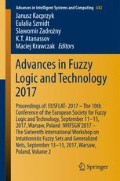Abstract
Edge detection remains a hot topic due to its importance as a low level operation for high level operations in computer vision and the fact that there is no edge detector that is optimal for all kinds of images. In this paper, a new edge detector is proposed. The algorithm relies on the concept of edge detection as an imbalanced binary classification problem. In particular, each pixel is characterized by a gradients feature vector and classified as edge or non-edge pixel by means of logistic regression and hysteresis. This algorithm outperforms other state-of-the-art edge detectors both from the visual and quantitative points of view.
Access this chapter
Tax calculation will be finalised at checkout
Purchases are for personal use only
Notes
- 1.
This image dataset can be downloaded from ftp://figment.csee.usf.edu/pub/ROC/edge_comparison_dataset.tar.gz.
- 2.
The details of the competition can be seen in http://irafm.osu.cz/edge2017/main.php.
References
Boaventura, I., Gonzaga, A.: Method to evaluate the performance of edge detector. In: Proceedings of SIBGRAPI 2009, pp. 1–3 (2009)
Bowyer, K., Kranenburg, C., Dougherty, S.: Edge detector evaluation using empirical ROC curves. In: IEEE Conference on Computer Vision and Pattern Recognition (CVPR 1999), vol. 1, pp. 354–359 (1999)
Canny, J.: A computational approach to edge detection. IEEE Trans. Pattern Anal. Mach. Intell. 8(6), 679–698 (1986)
Chawla, N.V., Bowyer, K.W., Hall, L.O., Kegelmeyer, W.P.: SMOTE: synthetic minority over-sampling technique. J. Artif. Int. Res. 16(1), 321–357 (2002)
Cox, D.R.: The regression analysis of binary sequences (with discussion). J. Roy. Stat. Soc. B 20, 215–242 (1958)
González-Hidalgo, M., Massanet, S., Mir, A., Ruiz-Aguilera, D.: On the generalization of the fuzzy morphological operators for edge detection. In: Alonso, J.M., Bustince, H., Reformat, M. (eds.) 2015 Conference of the International Fuzzy Systems Association and the European Society for Fuzzy Logic and Technology (IFSA-EUSFLAT 2015). Atlantis Press (2015)
Kovesi, P.D.: MATLAB and Octave functions for computer vision and image processing, http://www.csse.uwa.edu.au/~pk/research/matlabfns/
López, V., Fernández, A., García, S., Palade, V., Herrera, F.: An insight into classification with imbalanced data: empirical results and current trends on using data intrinsic characteristics. Inf. Sci. 250, 113–141 (2013)
Lopez-Molina, C., Bustince, H., Fernandez, J., Couto, P., De Baets, B.: A gravitational approach to edge detection based on triangular norms. Pattern Recogn. 43(11), 3730–3741 (2010)
Lopez-Molina, C., De Baets, B., Bustince, H.: Quantitative error measures for edge detection. Pattern Recogn. 46(4), 1125–1139 (2013)
Lopez-Molina, C., De Baets, B., Bustince, H., Sanz, J., Barrenechea, E.: Multiscale edge detection based on Gaussian smoothing and edge tracking. Knowl.-Based Syst. 44, 101–111 (2013)
Martin, D.R., Fowlkes, C.C., Malik, J.: Learning to detect natural image boundaries using local brightness, color, and texture cues. IEEE Trans. Pattern Anal. Mach. Intell. 26(5), 530–549 (2004)
Medina-Carnicer, R., Muñoz-Salinas, R., Yeguas-Bolivar, E., Diaz-Mas, L.: A novel method to look for the hysteresis thresholds for the Canny edge detector. Pattern Recogn. 44(6), 1201–1211 (2011)
Papari, G., Petkov, N.: Edge and line oriented contour detection: state of the art. Image Vis. Comput. 29(2–3), 79–103 (2011)
Perfilieva, I., Hodáková, P., Hurtík, P.: F1-transform edge detector inspired by Canny’s algorithm. In: Greco, S., et al. (eds.) Advances on Computational Intelligence: 14th International Conference on Information Processing and Management of Uncertainty in Knowledge-Based Systems, IPMU 2012. Proceedings, Part I, pp. 230–239. Springer, Heidelberg (2012)
Pratt, W.K.: Digital Image Processing, 4th edn. Wiley-Interscience (2007)
R Core Team. R: A Language and Environment for Statistical Computing. R Foundation for Statistical Computing, Vienna, Austria (2012)
Wang, R.: Edge detection using convolutional neural network. In: Cheng, L., et al. (ed.) Advances in Neural Networks, pp. 12–20. Springer (2016)
Acknowledgments
This paper has been partially supported by the Spanish Grant TIN2016-75404-P AEI/FEDER, UE.
Author information
Authors and Affiliations
Corresponding author
Editor information
Editors and Affiliations
Rights and permissions
Copyright information
© 2018 Springer International Publishing AG
About this paper
Cite this paper
Fernandez-Peralta, R., Massanet, S., Mir, A. (2018). A New Edge Detector Based on SMOTE and Logistic Regression. In: Kacprzyk, J., Szmidt, E., Zadrożny, S., Atanassov, K., Krawczak, M. (eds) Advances in Fuzzy Logic and Technology 2017. EUSFLAT IWIFSGN 2017 2017. Advances in Intelligent Systems and Computing, vol 642. Springer, Cham. https://doi.org/10.1007/978-3-319-66824-6_5
Download citation
DOI: https://doi.org/10.1007/978-3-319-66824-6_5
Published:
Publisher Name: Springer, Cham
Print ISBN: 978-3-319-66823-9
Online ISBN: 978-3-319-66824-6
eBook Packages: EngineeringEngineering (R0)

